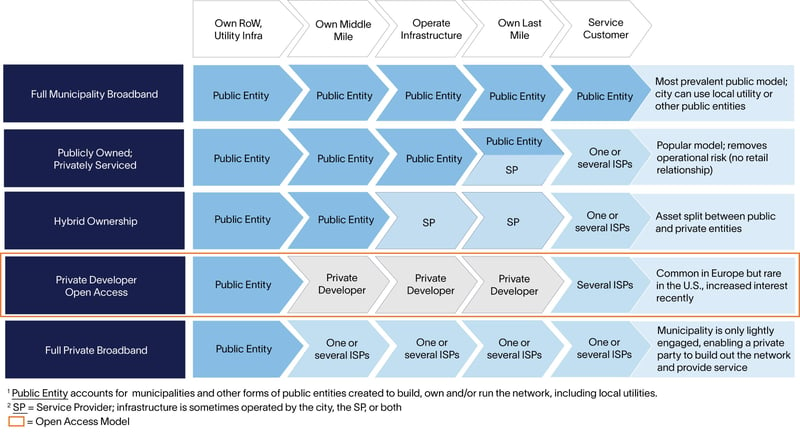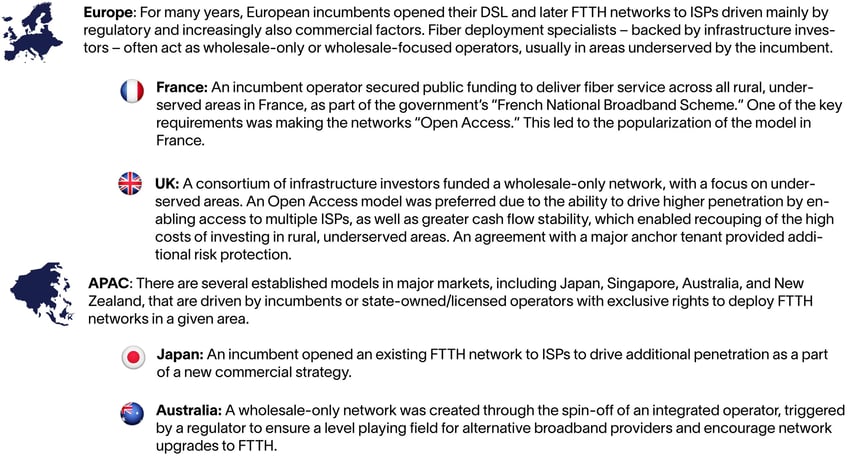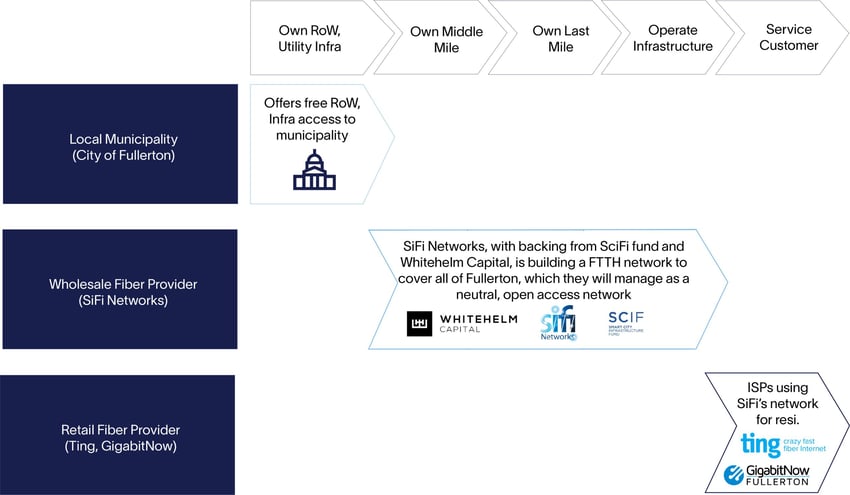INSIGHTS
The Case for Open Access: Providing Optionality for U.S. Municipalities
In 2020, Altman Solon collaborated with US Ignite on a report outlining strategies to boost broadband deployment across the United States. The report focused on how municipalities can create innovative public-private partnerships to deliver high-speed broadband access to underserved communities.
When we released the report two years ago, no one could have foreseen the pandemic that has changed the way we live, work, and communicate. During the isolation of COVID-19, access to quality broadband became more important for everything from work and entertainment to critical functions like medicine and public safety. The good news is that there has been meaningful progress for municipalities that have implemented some of the broadband deployment strategies in the report. In other areas, as in the case of Open Access, the momentum has continued to build but large-scale deployments remain nascent – although there are numerous use cases of this model in global markets that could help point the way for progress on Open Access in the U.S.
Progress since 2020
Despite the pandemic – and, in certain ways, because of it – there has been progress in accelerating broadband deployments in underserved communities:
- Increased national broadband funding – In 2021, the U.S. government committed more than $40 billion to improve broadband access and close the digital divide. While the implementation of this investment is only beginning, there is optimism that this historic investment will improve broadband access in underserved communities
- Public-private partnerships – The last few years have witnessed an expanded interest on behalf of municipalities collaborating with private LTE/wireless providers to complement municipal broadband
- Open access opens up? – There is a lot of talk around Open Access networks, and while not mainstream or widely adopted, they are continuing to gain momentum
What’s next?
Open Access is the key model to watch moving forward. In an Open Access network, the owner of a fiber infrastructure offers wholesale access to multiple interested broadband providers (“ISPs”) who can then use this single network to serve their clients. Thus, these ISPs do not need to build their own fiber networks to reach customers and the network owner achieves higher penetration. In other words, Open Access implies higher penetration on a single infrastructure instead of different infrastructures each with fewer customers. To achieve this, Open Access networks must enable any ISP to efficiently connect to the network and serve customers.
Business Model Options for Municipality Broadband Expansion

In the U.S., most of the investment dollars to this point have been directed to traditional (retail) delivery models, in which a single entity is responsible for network deployment, operations, marketing, and service. While Open Access networks are less common in the U.S., they have proven successful globally, as these networks can achieve higher penetration and thus higher revenue to Capex ratios for investors and developers. They are also particularly attractive for infrastructure investors due to their stability, high barriers to entry, long contract durations, and fewer retail and brand risks. Lastly, they also offer benefits to consumers, who now may have a choice of multiple ISPs versus just one.
Global success stories
Despite the global prevalence, there has been hesitation on behalf of municipalities and investors to leverage Open Access in the U.S. due to concerns over a lack of tenants to join the networks. This has created a “chicken-and-egg” problem, with (1) ISPs focusing on traditional/retail delivery while they wait for the wholesale networks to be built and (2) municipalities and investors waiting for ISPs to step forward and sign wholesale contracts. While these are valid concerns for investors, numerous examples in Europe and APAC have proven use cases and established wholesale models, often brought about by investment impetus, bankruptcy, or regulations:

These global examples show the variety of open-access models that could help the U.S. break the chicken-and-egg situation. It is also important to note that some progress is being made even in the U.S. to foster the growth of Open Access networks and hopefully, eventually, lead to the emergence of a diverse base of potential tenants. There has been an uptick in IT investments and large-scale partnerships with existing network developers, including important work by a handful of Open Access developers, like Si-Fi Networks, Underline, and Netly. For example, Si-Fi Networks has plans to launch Open Access networks across 30 cities in the U.S., while Underline is expanding beyond providing FTTH access to unify the billing process and provide other software features to the ISP.
Open Access U.S. example: SiFi Networks & the City of Fullerton

Key considerations
As Open Access models diversify and gain momentum, municipalities should consider the benefits of Open Access relative to alternatives. Architecturally, Open Access networks are not more expensive or complex to design and deploy compared to traditional networks, but they bring advantages regarding investor interest, network penetration, and revenue to Capex ratios. Some of the open-access network developers have also been investing in software and associated features to build a marketplace-like experience for the consumer. Lastly, Open Access enables a healthy, competitive environment, and provides optionality not only to potential new entrants but also to incumbents, who now could weigh the benefits of investing in upgrading their network versus joining a new Open Access network built by a developer in a given market.
It is important for municipalities to know that designing an Open Access network doesn’t immediately imply multi-tenancy; there are municipalities deploying them today with a single tenant in mind. They do provide optionality should that be the desired path in the future. With that mindset, building Open Access networks is a natural way to mitigate potential risks with limited downside.
Director Mat Grudzien will be speaking on a panel at the upcoming Smart Cities Connect Conference, April 4-7, 2022 in Columbus, Ohio. The panel will address how private municipal networks can be leveraged to improve connectivity and further close the digital divide evident across education, law enforcement, telehealth, general IoT infrastructure, and more. Learn more about the Smart Cities Connect Conference here.